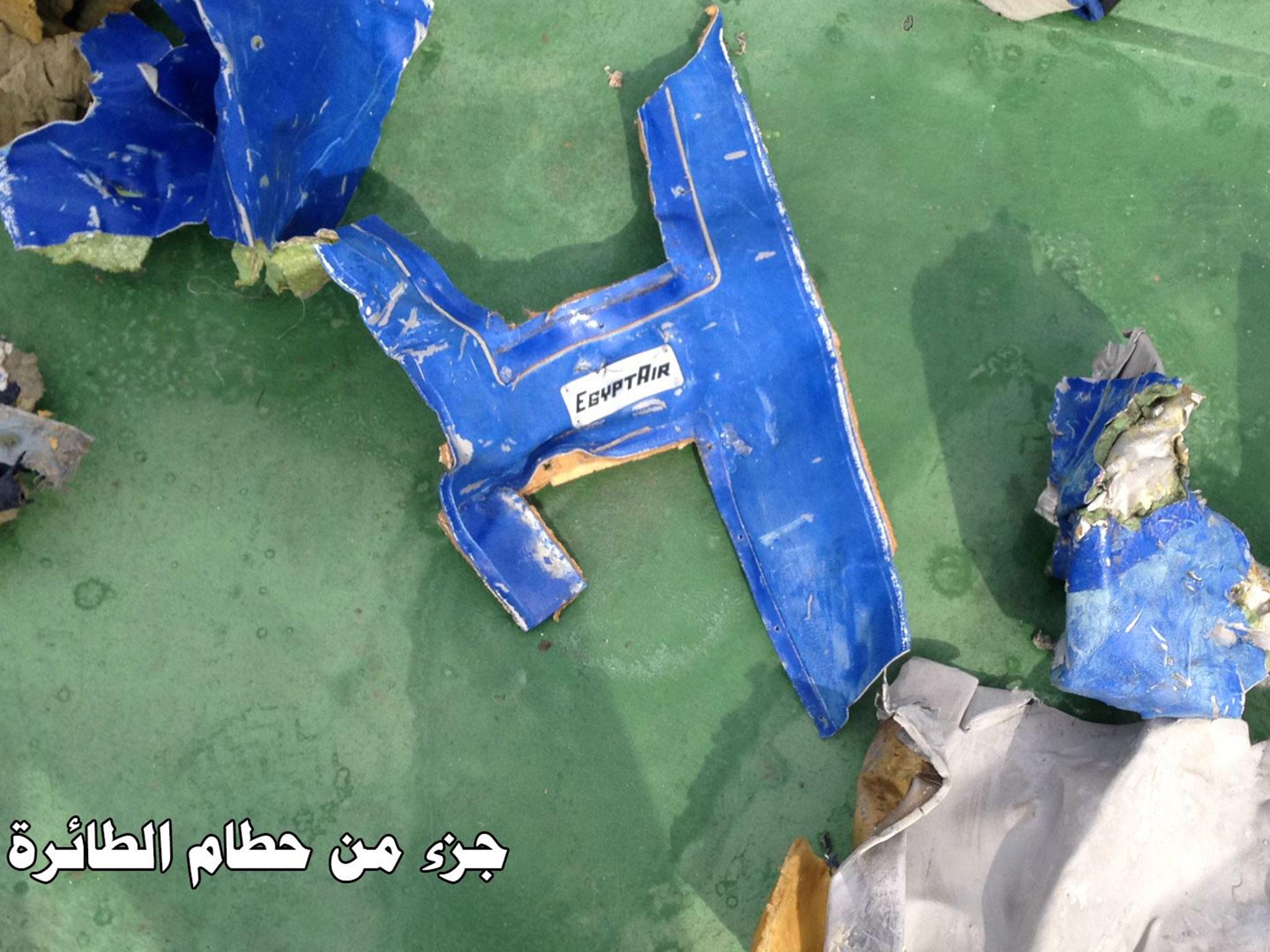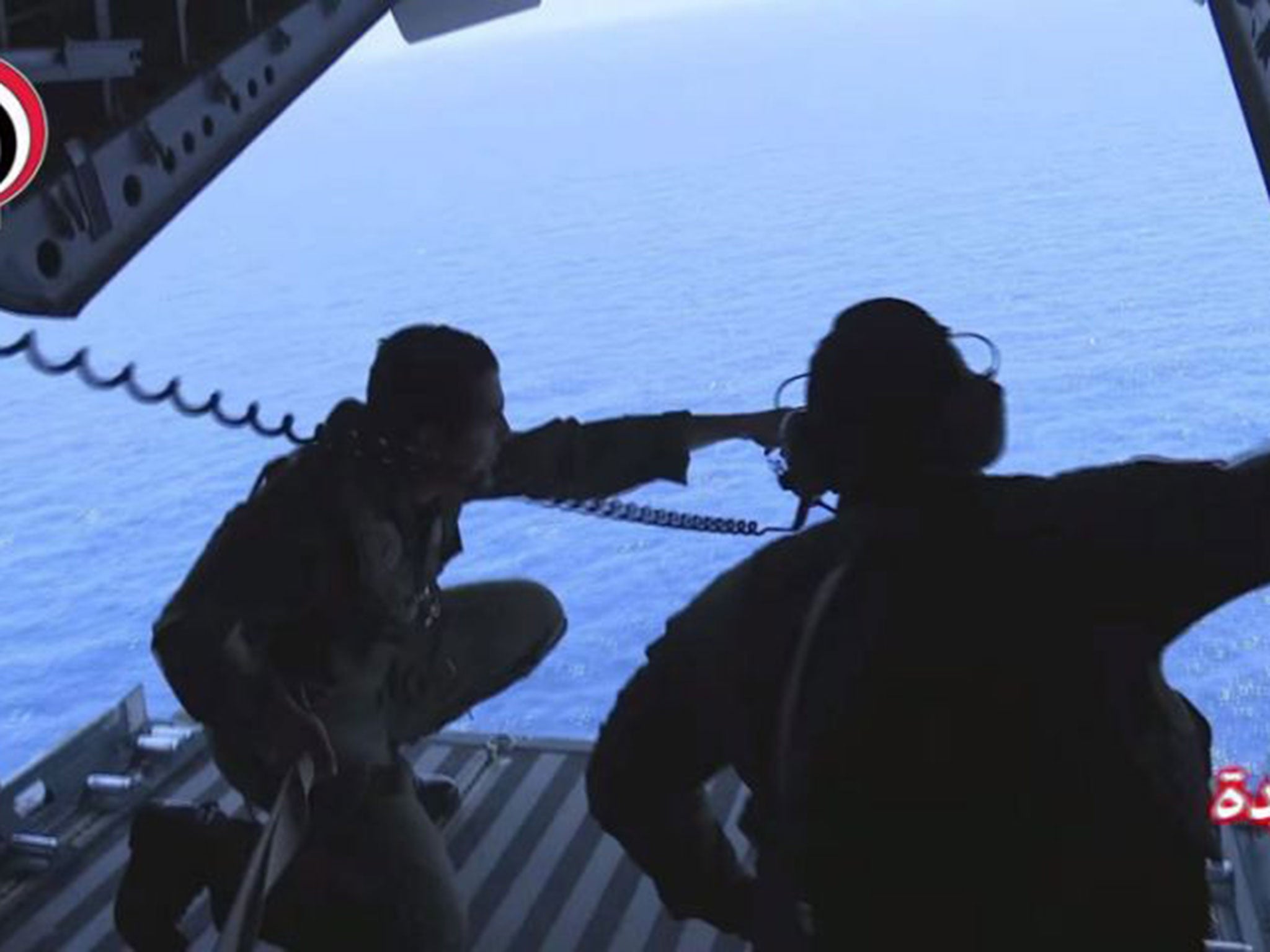EgyptAir flight MS804 crash: Egyptian military posts first photos of wreckage showing mangled plane parts and seats
The items are being analysed for clues on what caused the flight to crash into the Mediterranean Sea
The Egyptian military has published the first images of wreckage from EgyptAir flight 804, showing mangled parts of the fuselage, life jackets and passengers' belongings.
The airline’s logo can clearly be seen on several of the items recovered during search operations in the Mediterranean Sea, where the plane crashed on Thursday killing everyone on board.
Brigadier General Mohammed Samir, a spokesperson for the Egyptian army, said the photos published on Saturday morning showed wreckage of the missing plane and personal possessions.

One picture appeared to show part of the Airbus A320’s metal body, while another showed an uninflated life jacket and one item that looked like part of a child's bag or blanket.
Officials said the items had been found on Friday as military planes, helicopters and ships continued to scour the area between the Greek island of Crete and Egyptian coastal city of Alexandria where the plane disappeared from radar.
Phil Giles, a former air safety investigator who worked on the Lockerbie Bombing case, told The Independent that the wreckage images added to mounting indications the plane broke up mid-air.
“All the evidence so far, including the pictures, indicates that the aircraft broke up at altitude rather than when it impacted the sea,” he said.
“Aircraft do infrequently break up as a function of severe weather however this wasn't a factor in this accident.
“Modern aircraft such as the A320 don't have a habit of suffering major structural failure unless there is some external factor like a BUK missile as in the case of MH17, or an internal device.”
Mr Giles said he favoured the latter explanation, meaning a bomb may have been planted on board, but needed more evidence.
Investigators are hoping for the swift discovery of the plane’s flight recorders, known as black boxes, which hold detailed data on its last moments.
But Mr Giles warned that even they may not confirm what caused the break-up as the process can cut data communications.
“Most of the data is sensed and acquired at the front of the aircraft and travels by datalink to the recorders at the rear which are in simple terms, very large capacity non-volatile memory sticks,” he added.
“If you break the aircraft in half suddenly the data link is cut and so you may only see what was happening immediately before the explosion, as with MH17 and PanAm 103 for that matter.”
Body parts, seats, luggage and wreckage seen floating around 180 miles north of Alexandria were being analysed to provide clues to the cause of the disaster.
Smoke was detected in multiple parts of the aircraft moments before it plummeted into the sea, analysis of automatic messages has shown, but the cause of the crash remains unclear.

The search continued on Saturday, with a French navy patrol boat equipped with sonar is on its way from the port of Toulon.
The 262-foot ship will aim to identify the sound of the underwater location beacons fitted to the crashed plane's cockpit voice and flight data recorders, known as black boxes.
The Navy says it will take two to three days for the vessel and its crew of 90 to arrive in the search zone, which is roughly halfway between Egypt's coastal city of Alexandria and the Greek island of Crete.
It may take some time to find the recorders — the water is 8,000 to 10,000 feet deep and an oceanographer likened the sea floor to the Alps.
Dr Simon Boxall told BBC that the A320 could easily “slip through the cracks” of the ocean floor or be lost in soft sediment several kilometres down.
“It sits on a boundary where the ocean floor is more like the Alps, very rugged and contoured,” he said. “This is a very soft sediment area and wreckage could sink very quickly, so they need to find it fast.”
Families of the 66 people on board were told their loved ones were dead on Friday, with many gathering for an emotional memorial service at a mosque in Cairo.

Among the victims was Richard Osman, a father-of-two from Wales, and a Frenchman who almost missed the fated flight after losing his passport.
EgyptAir said 30 Egyptians, 15 French passengers, two Iraqis, and one passenger from Britain, Sudan, Chad, Portugal, Algeria, Canada, Belgium, Kuwait and Saudi Arabia were on board.
The scheduled flight left Charles de Gaulle at 11.09pm on Wednesday (10.09 BST) and radar shows it continued on its normal path over Italy and Greece before starting to cross the Mediterranean.
The last signal was picked up by Greek air traffic control at 2.27am (1.27am BST) and the country’s civil aviation ministry said the previously “jocund” pilot did not respond to contact attempts as the plane headed towards Egyptian airspace.
Egyptian authorities lost contact with the flight at around 2.30am (1.30am BST), 45 minutes before it was due to land at Cairo International Airport.
The Greek defence minister said the plane had been cruising at an altitude of 37,000ft when it started rapidly losing altitude, suddenly veering to the left and then making a full circle in the opposite direction immediately after it entered Egyptian airspace.
The aircraft dropped by 22,000ft to 15,000ft before contact was lost at around 10,000ft.
Smoke was detected on board moments before it plummeted into the sea, France’s BEA air accident investigation said.

Spokesperson Sebastien Barthe said the plane's automatic detection system sent several messages, while industry publication Aviation Herald said sensors detected smoke in the toilet.
The revelation provoked widespread speculation of a fire but Mr Barthe said that although the messages “generally mean the start of a fire,” it was not proof.
“We are drawing no conclusions from this,” he added. “Everything else is pure conjecture.”
Egyptian authorities said they believe terrorism is a more likely explanation than mechanical failure, and some aviation experts have said the erratic flight suggests a bomb blast or a struggle in the cockpit.
But no conclusive evidence has been emerged and there has been no claim of responsibility by Isis or al-Qaeda, and a marked lack of “chatter” among jihadists.
Investigators have been looking into the background of the passengers and crew on board, while questioning staff at Charles de Gaulle Airport who had contact with the aircraft before it took off.
Meanwhile, the search for wreckage continues with planes and ships from Egypt, Greece, Britain, France, the US and Cyprus combing the eastern Mediterranean.
In Paris, French Foreign Minister Jean-Marc Ayrault was due to meet family members of the passengers and crew on Saturday.
He said the meeting at the Foreign Ministry would be aimed at giving family members as much information as possible.
“The whole truth, nothing but the truth,” he added. “We owe it to the families.”
Join our commenting forum
Join thought-provoking conversations, follow other Independent readers and see their replies
Comments